To understand the diseases and conditions that can affect the eye, it helps to understand basic eye anatomy. Here is a tour of the eye starting from the outside, going in through the front and working to the back.
Eye Anatomy: Parts of the Eye Outside the Eyeball
The eye sits in a protective bony socket called the orbit. Six extraocular muscles in the orbit are attached to the eye. These muscles move the eye up and down, side to side, and rotate the eye.
The extraocular muscles are attached to the white part of the eye called the sclera. This is a strong layer of tissue that covers nearly the entire surface of the eyeball.
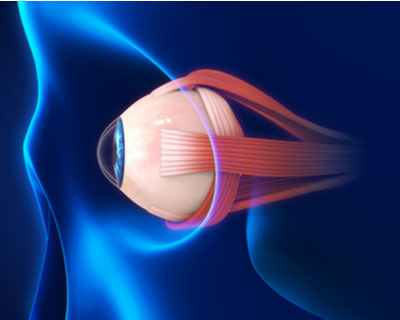
This illustration shows eye muscles, which control eye movement.
The Surface of the Eye
The surface of the eye and the inner surface of the eyelids are covered with a clear membrane called the conjunctiva.
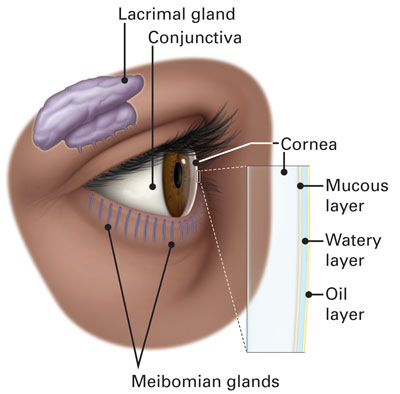
The layers of the tear film keep the front of the eye lubricated.
Tears lubricate the eye and are made up of three layers. These three layers together are called the tear film. The mucous layer is made by the conjunctiva. The watery part of the tears is made by the lacrimal gland. The eye’s lacrimal gland sits under the outside edge of the eyebrow (away from the nose) in the orbit. The meibomian gland makes the oil that becomes another part of the tear film. Tears drain from the eye through the tear duct.
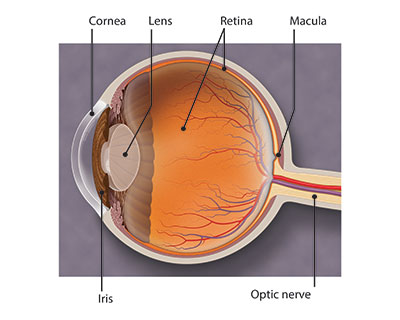
The Front of the Eye
Light is focused into the eye through the clear, dome-shaped front portion of the eye called the cornea.
Behind the cornea is a fluid-filled space called the anterior chamber. The fluid is called aqueous humor. The eye is always producing aqueous humor. To maintain a constant eye pressure, aqueous humor also drains from the eye in an area called the drainage angle.
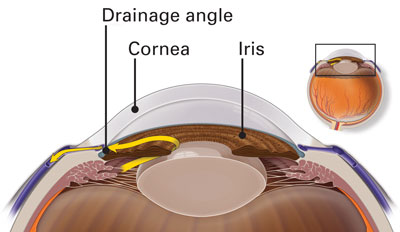
Behind the anterior chamber is the eye’s iris (the colored part of the eye) and the dark hole in the middle called the pupil. Muscles in the iris dilate (widen) or constrict (narrow) the pupil to control the amount of light reaching the back of the eye.
Directly behind the pupil sits the lens. The lens focuses light toward the back of the eye. The lens changes shape to help the eye focus on objects up close. Small fibers called zonules are attached to the capsule holding the lens, suspending it from the eye wall. The lens is surrounded by the lens capsule, which is left in place when the lens is removed during cataract surgery. Some types of replacement intraocular lenses go inside the capsule, where the natural lens was.
By helping to focus light as it enters the eye, the cornea and the lens both play important roles in giving us clear vision. In fact, 70% of the eye's focusing power comes from the cornea and 30% from the lens.
The Back of the Eye
The vitreous cavity lies between the lens and the back of the eye. A jellylike substance called vitreous humor fills the cavity.
Light that is focused into the eye by the cornea and lens passes through the vitreous onto the retina — the light-sensitive tissue lining the back of the eye.
A tiny but very specialized area of the retina called the macula is responsible for giving us our detailed, central vision. The other part of the retina, the peripheral retina, provides us with our peripheral (side) vision.
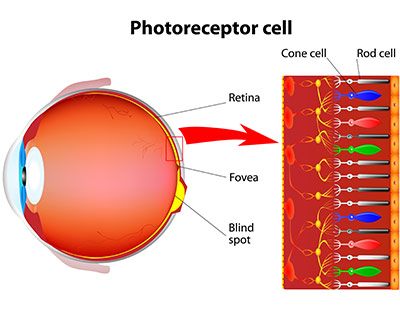
The retina has special cells called photoreceptors. These cells change light into energy that is transmitted to the brain. There are two types of photoreceptors: rods and cones. Rods perceive black and white, and enable night vision. Cones perceive color, and provide central (detail) vision.
The retina sends light as electrical impulses through the optic nerve to the brain. The optic nerve is made up of millions of nerve fibers that transmit these impulses to the visual cortex — the part of the brain responsible for our sight.